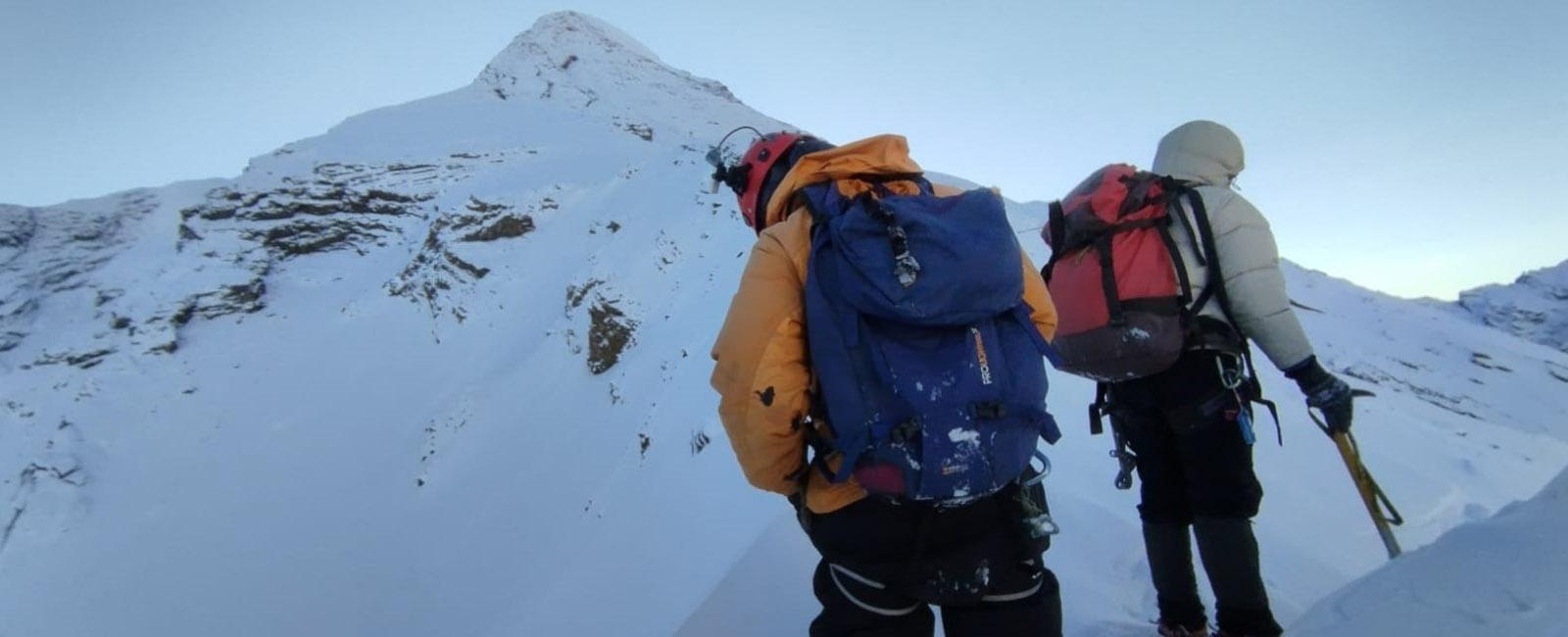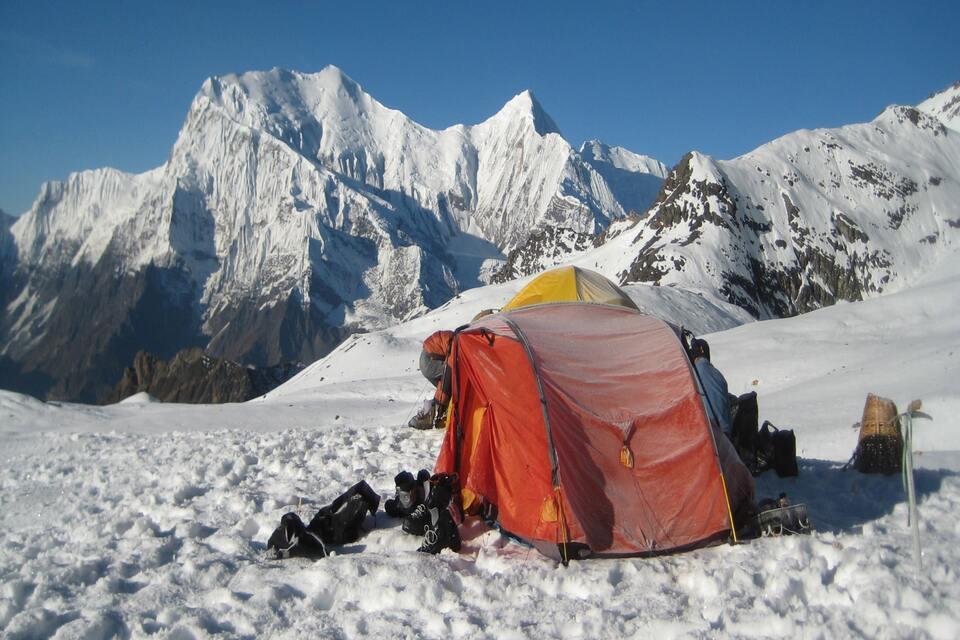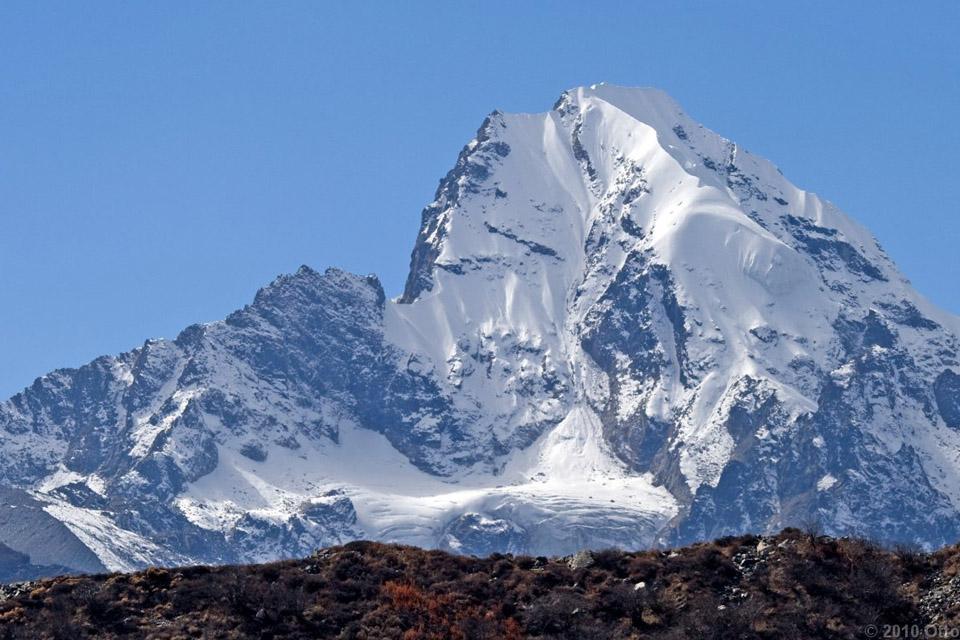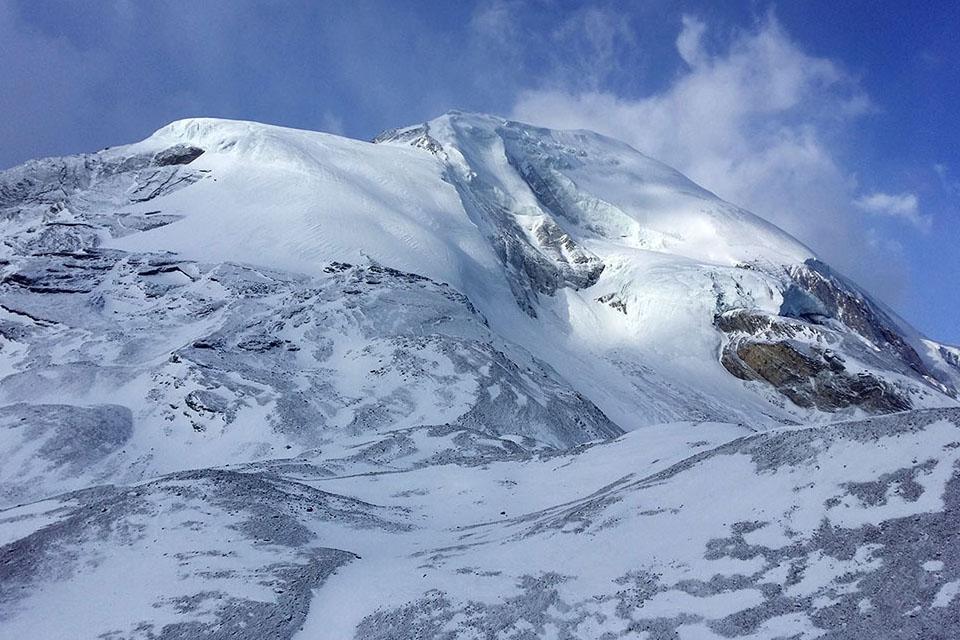Pisang Peak Climbing
Trip at a Glance
Pisang Peak is located in the Annapurna region rising to an elevation of 6,091 meters (19,983 feet). The peak is exactly located between the Annapurna ranges and Manaslu. Because of its comparatively easy approach and breathtaking views of the neighboring Himalayan mountains, it is a popular peak for climbers. Pisang peak climbing difficulty despite being characterized an easy climbing peak, a successful journey requires a reasonable level of fitness and good health.
A German expedition team made the first successful ascent of Pisang Peak in 1955. After that, Pisang Peak gained popularity and is now a popular trekking peak in the Annapurna region. Pisang peak climbing from Kathmandu starts with a drive to Chame via Besisahar then start trekking towards Pisang village passing along lush forests, traditional villages, and scenic landscapes.
Upon reaching the summit of Pisang Peak, astonishing views of the majestic peaks like Annapurna range, including Annapurna II, III, and IV, Gangapurna, and Tilicho Peak awaits the climber.
Marron Treks' 15-days Pisang peak climbing itinerary offers a remarkable peak climbing adventure combining trekking and climbing in Nepal at one of the most popular trekking destination in the Himalayas.
Pisang peak climbing Highlights
- Summiting 6,000-meter class peak in the Himalayas
- Witness stunning panoramic views of peaks like the Annapurna and Manaslu ranges
- Crossing over high mountain passes, Mesokanto Pass (5025m)
- Hike to Tilicho Lake (4920m), one of the highest lakes in the world
- Discover traditional Gurung and Manangese villages with rich Buddhist culture
- Following the Annapurna Circuit trail exploring the Annapurna region
- Trek past the Annapurna Conservation Area, home to unique flora and fauna
Pisang peak climbing difficulty
Although it's not as technical as some other trekking peaks, there are some steep parts, some scrambling, and some places where ropes and ice axes are needed. Because of the terrain and altitude, the final ascent to the summit can be challenging. Pisang peak climbing is suitable for people with some prior trekking experience and a basic understanding of mountaineering techniques, but it does demand a good level of physical fitness. Significant altitude challenges arise while climbing to elevations above 6,000 meters. The Himalayan weather can be unpredictable with sudden changes in wind and temperature, therefore one must be ready for it.
Pisang Peak climbing in autumn/spring
The most popular and recommended times for this Himalayan adventure are in autumn and spring, when climbing Pisang Peak gives a high success rate.
Spring (March to May) offers warmer temperatures and more stable weather patterns. There is good visibility of the nearby Annapurna peaks due to the frequent clear sky.During this season, the region's flora flourishes, producing a spectacular landscape.
During this time of the year, lower elevations will have warmer temperatures. Climbers will be greeted with beautiful scenery with rhododendrons and other flowers in bloom. There will be longer hours of daylight. There will be more hikers and climbers on the trails during this popular trekking and climbing season.
Autumn (September to November) The monsoon season is followed by autumn, which brings dry weather and clear skies. The Himalayan range can be seen clearly because to the clear, crisp air. Climbing will be more enjoyable with cool weather especially at higher elevations.
During autumn it will be clear sky and good visibility. Weather is dry, stable and cooler which is ideal for climbing. Rain is less likely to happen though nights will be cold. Similar to spring, autumn is a popular time of year, so there will be more people on the trails.
Pisang Peak is a good to climb in both spring and autumn. Autumn brings bright sky and good visibility, while spring brings warmer temperatures and flowering beauty. But regardless of the season, one should also be ready for cold temperatures and possible weather changes at high elevations.
Altitude sickness prevention on Pisang Peak climb
Altitude sickness is a major concern because climbing Pisang Peak requires reaching higher elevations. The most important factor is gradual acclimatization. Take your time climbing so that your body can adjust to the lower oxygen levels. You should include rest days in your itinerary, particularly as you ascend higher in the region. Follow the "Climb high, sleep low" strategy which means during the day, ascend to high altitudes, while at night, drop to lower elevations.
Be sure to stay hydrated. Dehydration from high altitudes provokes the symptoms of altitude sickness. Stay away from caffeine and alcohol as these can cause dehydration. You should eat a diet rich in carbohydrates and well-balanced food avoiding fatty, greasy foods. Get enough sleep and rest. Don't put too much effort on yourself. Go slowly and steadily and take it easy.
Consulu with your doctor about medications that can help avoid altitude sickness, such as acetazolamide (Diamox). Medication, however, cannot replace an proper acclimatization. Keep a watchful eye out for any altitude sickness symptoms, such as headache, nausea, lightheadedness, or dyspnea. Notify your guide right away if you encounter any symptoms. Descend to a lower altitude if symptoms get worse.
A good natural acclimatization is included in the Annapurna Circuit itinerary, which is combined with Pisang Peak climbs. Make use of the circuit's gradual ascent to your benefit. Besides experienced guides are crucial for the climb. They can keep an eye on your health and offer valuable guidance on acclimatization. Having a guide with extensive knowledge in high altitude mountaineering is crucial.
Regardless of age or level of fitness, anyone can get altitude sickness. It's critical to prioritize your safety and treat it seriously.
Pisang Peak climbing permits and regulations
Pisang Peak climbing needs particular permits and compliance with rules to guarantee a responsible and safe ascent. Trekking and climbing within the Annapurna Conservation Area, which includes Pisang Peak, require an Annapurna Conservation Area Permit (ACAP). ACAP is responsible for tourism in the area and promotes conservation initiatives.
Climbing Permit for Pisang peak is the particular permit needed to climb Pisang Peak. The Nepal Mountaineering Association (NMA) is the organization that issues it. The fee depends upon high and low climbing season which is as below.
Pisang peak climbing permits price
1) ACAP permit fee for foreigners: NPR 3,000 (Approx. USD22)
2) Trekking Information Management System (TIMS) card permit: NPR 2000 (Approx. USD15)
4) Royalty for Foreign climbers for Pisang peak (per person in US dollar)
Spring (March-April-May) USD250
Autumn (Sept-Oct-Nov) USD125
Winter (Dec-Jan-Feb) USD70
Summer June-July-Aug) USD70
5) Garbage deposit USD500 (Refundable)
Itinerary
Day 01: Arrival in Kathmandu
Day 02: In Kathmandu - Preparation Day
Day 03: Drive from Kathmandu to Besisahar (823m/7-8 hrs)
Day 04: Drive from Besisahar to Chame (2,715m/6-7 hrs)
Day 05: Trek from Chame to Upper Pisang (3240m/5-6 hrs)
Day 06: In Upper Pisang (3240m) – Rest/Acclimatization
Day 07: Trek from Upper Pisang to Pisang Base Camp (4380m/4-5 hrs)
Day 08: Trek from Pisang Base Camp to High Camp (5400m/4-5 hrs)
Day 09: High Camp to Summit Pisang Peak (6,091m) & descend to Pisang Base Camp (4380m/8-9 hrs)
Day 10: Trek from Pisang Base Camp to Manang (3450m/6-7 hrs)
Day 11: Trek from Manang to Siri Kharka (4,060m/4-5 hrs)
Day 12: Trek from Siri Kharka to Tilicho Base Camp (4,150m/5 hrs)
Day 13: Trek from Tilicho Base Camp to Tilicho Lake (4920m/5 hrs)
Day 14: Cross the Mesokanto Pass (5025m) & trek to Kharka (3600m/8 hrs)
Day 15: Trek from Kharka to Jomsom (2670m/5 hrs)
Day 16: Fly from Jomsom to Pokhara (822m/25 min)
Day 17: Fly or drive from Pokhara to Kathmandu (1400m)
Day 18: Final Departure
Arrive in Kathmandu and one of our representatives will receive you and transfer you to your hotel in Kathmandu. The rest of the time is free to explore the city or you can simply rest at your hotel if you are jet lagged and get ready for an amazing Himalayan trek/climb.
Our office team and climbing guide will meet you at the hotel and provide you further details regarding the trip completing your trip's paperwork and permission and conduct a last inspection of your climbing gear. You will have the opportunity to purchase any extra gear you may require today. Another option is to take a sightseeing tour of the Kathmandu Valley.
Early in the morning begin your journey with a scenic drive from Kathmandu to Besisahar which is about 7-8 hours and a smooth drive, passing through lush green hills, terraced farmlands, and small roadside villages. The road winds along the Trishuli and Marsyangdi rivers along the way, providing stunning views. Upon arrival in Besisahar, check into your lodge and prepare for the adventure ahead.
Continue your journey from Besisahar to Chame, the administrative center of the Manang District. The road ascends steeply now beginning an off-road though offering views of cascading waterfalls, pine forests, and snow-capped peaks like Lamjung Himal and Annapurna II. Reach Chame, where you’ll acclimatize to the higher altitude and enjoy the mountain scenery.
Your trek begins today with a trail that winds through dense forests and crosses suspension bridges over the Marsyangdi River. You will gradually climb to Upper Pisang, where you’ll be greeted by breathtaking views of Annapurna II and IV. Explore the village, known for its traditional stone houses and prayer wheels.
Today is rest and acclimatization in the altitude. Take short hikes around Upper Pisang to adapt to the environment while enjoying panoramic views of the surrounding peaks and immerse yourself in the tranquil mountain atmosphere.
The trail ascends toward Pisang Peak Base Camp. You pass through alpine landscapes with spectacular views of the Annapurna range. Arrive at the base camp and prepare for the summit attempt in the days ahead.
The trail climbs to Pisang Peak High Camp where the trail becomes steeper and more rugged as you ascend to higher altitudes. Upon reaching the high camp, set up tents and rest in preparation for the summit push.
Today is the big day so start early for the summit attempt of Pisang Peak. The climb involves technical sections and requires the use of ropes and crampons. Upon reaching the summit, enjoy breathtaking views of the Annapurna and Manaslu ranges. After celebrating your success, descend carefully to base camp.
The trail descends from base camp and you will follow the trail toward Manang. The trek offers stunning views of the Annapurna range and passes through lush forests and traditional villages. Arrive in Manang, a vibrant Himalayan town, and enjoy a relaxing evening.
You will ascend toward Siri Kharka. The trail offers incredible views of Gangapurna and other peaks. Siri Kharka is a quiet spot, perfect for resting and enjoying the serene surroundings.
You will follow rugged trails and narrow paths toward Tilicho Base Camp. The area offers a dramatic landscape with cliffs and snow-capped peaks. Arrive at the base camp and prepare for the hike to Tilicho Lake.
Today start early to Tilicho Lake, one of the highest-altitude lakes in the world. The trail is challenging but rewards you with stunning views of the lake surrounded by towering peaks. Spend time admiring the serene beauty of the lake.
Start early to cross the Mesokanto Pass, a challenging high-altitude route with breathtaking views. After crossing the pass, descend to Kharka, where you’ll rest for the night amidst tranquil landscapes.
The trail descends to Jomsom, a bustling town in the Kali Gandaki Valley. Enjoy the stark contrast of arid landscapes and vibrant local culture. Celebrate the completion of the trekking section of your adventure.
Take a short and scenic 25-minute flight from Jomsom to Pokhara enjoying panoramic views of the Annapurna and Dhaulagiri mountain ranges and the stunning Kaligandaki River Gorge. Arrive at Pokhara Airport. Transfer to your hotel and the rest of the time is free to explore.
Fly back to Kathmandu (25 min) with scenic aerial views of the Himalayas. Upon arrival, explore the city or enjoy a farewell dinner. Drive from Pokhara to Kathmandu takes about 8-9 hours.
Today is your final day in Nepal. A representative of Marron Treks will escort you to the Tribhuvan International Airport, three hours to your flight schedule. Have a safe flight back home!
What is included?
- Airport pick-up and drop services.
- Hotel accommodations in Kathmandu & Pokhara with breakfast on Twin Share Basis.
- Kathmandu to Chame drive via Besisahar by private vehicle/local jeep.
- All trekking accommodations with Breakfast/Lunch/Dinner at local lodges & tents on twin-sharing basis.
- A comprehensive medical kit (will be carried by the trekking guide)
- Four seasonal sleeping bags and duffel bags (to be returned after trip completion)
- Experienced government-licensed climbing guide & porters (1 porter for two people) including their food, accommodation, & salary.
- Group climbing gear like climbing rope, ice screws, snow bars etc.
- All camping equipment required during the climb (sleeping tents/mattresses, kitchen tent, kitchen equipment).
- Personal insurance for climbing/trek crew.
- Jomsom/Pokhara by flight with guide.
- Annapurna Conservation entry permit & TIMS Card.
- Pisang Peak Climbing Permit.
- Pokhara/Kathmandu transfers by a tourist bus or private vehicle (Option: Flight)
- Farewell dinner with Nepalese cultural program.
- All government and local taxes.
What is not included?
- International airfares.
- Nepal entry visa fee – Visa can be obtained upon your arrival at the Tribhuvan International Airport in Kathmandu. (USD30 for 15 days)
- Lunch & dinner in Kathmandu or Pokhara.
- Personal travel insurance.
- Emergency rescue evacuation (to be covered by the client's travel insurance).
- Other expenses of a personal nature (phone calls, laundry, battery recharge, bottle or boiled water, hot shower etc.)
- Personal climbing gear.
- Bar bills, alcoholic drinks & beverages.
- Garbage deposit fees (refundable).
- Tips for guides and porters (Tipping is expected).
Trip Info
Accommodation
While you are in Kathmandu, we opt to accommodate you in 4- or 5-star hotels like Hotel Royal Singhi (4-star), Hotel Manaslu (4-star), Radisson (5-star), Yak & Yeti (5-star), or similar. During the trek, you will be accommodated in a local mountain lodge, better known as Tea House. These lodges and teahouses provide good services and are equipped with basic amenities. During the climb, we will provide top-quality camping equipment, including premium member tents, a spacious dining tent, and a hygienic toilet tent. We will endeavor to provide you with the best accommodation available along the route so that you get a good night’s rest in a hygienic milieu.
Meals
We never compromise the quality of food or the health of the trekkers as well as the crew members. Generally, we opt for the fresh and nutritional local community food available. You could make your delicious pick from an array of traditional foods like Sweet potatoes, buckwheat barley, etc. This way, you could not only get a real sense of the local culture and life patterns but also contribute to promoting the locally available resources of organic food and beverages. Besides, a wide range of Continental, Chinese, Italian and Indian cuisines like Pizza, Spaghetti, French Fries, Soups, Breads, Masala curry, etc. are also available in the restaurants for your retreat. During the camping, our experienced cook will prepare nutritious and hygienic meals for you.
Acclimatization
Altitude sickness is a serious risk while trekking in the Himalayas. It's important to acclimatize properly by spending a few days at lower altitudes before heading higher. By spending time at lower altitudes before pushing higher, your body has time to adjust. Our trekking packages have enough acclimatization days planned where you'll be spending a day or two at lower altitudes, allowing your body to adjust to the increasing altitude.
Electricity & drinking water
For an additional cost, you can use the electricity in all tea houses and lodges to recharge your batteries. The lodges have packaged mineral water for sale, or you can fill your bottle with boiling water. To make water drinkable, you can use water purification tablets too. But, due to hygienic issues, you should avoid drinking water from taps, rivers, or wells in trekking areas.
Communication
At lodges, restaurants, and hotels, Wi-Fi is available for an additional fee in the most popular trek regions, like Everest, and Annapurna. However, at high elevations, phone calls are the only means of connection. Our office in Kathmandu is in constant communication with your trek guide. In Kathmandu, you can purchase a local sim card for communication purposes. At high elevations, the mobile signal might not be as strong, though.
Luggage
Our porters are paired with one trekker for every two hikers, and one porter can safely carry 30 kg maximum weight. Therefore, we advise you to fill your duffle bag not more than 15 kg with your belongings. You may carry a small backpack with your valuables and informational documents. The things you are not taking along on the trek can be stored in a hotel in Kathmandu free of cost.
Typical Trek Day
Mostly your trek day starts with breakfast at 7-8 am, followed by a 3-4 hour morning trek. Lunch break is around an hour, then you continue trekking to your destination for the day. After reaching the teahouse lodge, you can relax, explore nearby areas, and enjoy dinner at 6-7 pm. Evenings involve socializing, a trek briefing, and leisure activities before bed.
Travel Insurance
It is advised that you arrange your travel insurance before leaving your homeland. The main thing is to make sure that your insurance covers you for both- medical and evacuation costs. Having travel insurance with you makes your trip secure and hassle-free.
Our Guides
Guides play a significant role during the trek. They are the ones who literally decipher the trekking codes for you so that you can actually connect with nature, culture and people along the way. We have helpful and dedicated trekking guides who are very well-versed in the culture, life patterns and every single detail pertaining to the trek region you are traveling in. Thus, in the company of our professional Sherpa guides, your trek becomes not only entertaining but also equally informative.
Porter and Staff Care
When it comes to high-altitude trekking, porters and staff members make up a pivot. Marron Treks ensures that all the porters and staff members going to high altitudes are provided with adequate clothing and equipment. All our field staff are covered by insurance.
About the guide

Dhan Kumar Tamang
- A certified and professional climbing guide who has successfully led numerous expeditions to peaks ranging from 6,000 to 8,000 meters in Nepal.





